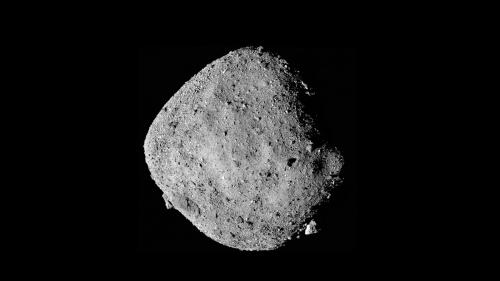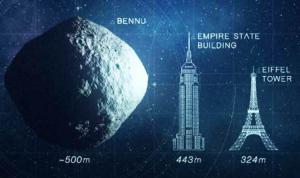Celebration of Space - September 22, 2023
This coming Sunday, September 24, 2023, will be a big day for asteroid research when the Origins, Spectral Interpretation, Resource Identification, and Security-Regolith Explorer (OSIRIS-Rex) mission drops a sample of the large asteroid, 101955 Bennu, in the desert of Utah. Which will complete the seven year mission.
OSIRIS-Rex launched in September 2016, embarking on a journey to the asteroid, which is classified as an Apollo class Near Earth Asteroid (NEA) that resides on the Sentry Risk Table of potentially hazardous objects. On December 3, 2018, the spacecraft arrived at Bennu and assumed orbit on December 31, 2018, this kicked off the Orbit A navigation phase of the mission. This phase allowed for the mission team to study and gain experience navigating in close proximity to the asteroid. On March 11, 2019 the spacecraft changed its orbit to allow for close fly-by passes, which started the Detailed Survey phase of the mission. The goal of this phase is to completely map the surface of Bennu. On October 3, 2019, the spacecraft began its Reconnaissance A mission phase, which altered the orbit to allow for investigation of four sample collection site candidates. On December 12, 2019, the mission team selected the Nightingale site for sample collection. Over the next six months the spacecraft altered its orbit, and completed several very close flybys of the Nightingale site. On October 20, 2020, OSIRIS-Rex performed a touch-and-go maneuver, successfully collecting a sample of 60 grams from Bennu’s surface. On May 10, 2021, the spacecraft departed Bennu, and began its return journey to Earth with an arrival date slated for September 24, 2023 to return the collected sample.
Asteroid 101955 Bennu is a common type of asteroid that is part of a group of asteroids called B-type asteroids, which are primitive remnants from the early formation of the Solar System. Bennu has an equatorial diameter of about 0.33 miles, which is slightly wider than the height of the Empire State Building. Bennu has a mass of 85.5 million tons. It takes 1.2 years for Bennu to complete one full orbit around the Sun and makes a close approach to Earth on a six year interval. There is a credible risk that Bennu will impact Earth between the years 2178 and 2290, with the biggest risk occurring on September 24, 2182.
The sample return on Sunday will be broadcast on NASA TV, with coverage starting around 10:00 am ET. You can also register to attend the virtual sample return event, which will get you additional access and a stamp on your virtual guest passport. Register here. Regardless of how you choose to attend, this will be a fabulous end to a high profile mission, which has allowed us to learn an incredible amount about these types of asteroids. Learn more about the OSIRIS-Rex mission, and keep your fingers crossed for a successful sample return.
Evening passes of the International Space Station (ISS) will continue this weekend and coming week. We have had a few stunning passes of the ISS this past week, and most passes for the coming nights will be a bit lower than usual, but still visible as long as the sky is clear.
Fri, Sep 22 at 8:17 pm, starting in the NW, rising to 14°, heading towards the NNE, and into orbital sunset
Sat, Sep 23 at 7:29 pm, starting in the NW, rising to 14°, heading towards the NNE
Sun, Sep 24 at 8:18 pm, starting in the NW, rising to 16°, and into orbital sunset
Mon, Sep 25 at 7:30 pm, starting in the NNW, rising to 15°, heading towards the NE
Tue, Sep 26 at 8:19 pm, starting in the NW, rising to 23°, and into orbital sunset
Wed, Sep 27 at 7:31 pm, starting in the NNW, rising to 19°, heading towards the NE, and into orbital sunset
Thu, Sep 28 at 7:31 pm, starting in the NW, rising to 30° heading towards the ENE, and into orbital sunset
Additionally, China’s space station, Tiangong, will also return to the evening sky this coming week. Offering up fabulous passes that are easy to see. As China’s station continues to expand, it is getting quite bright, not fully as bright as the ISS, but close. Here is the only notable pass of Tiangong for this coming week:
Wed, Sep 27 at 8:03 pm, starting in the SSW, rising to 16°, and into orbital sunset
You will notice that orbital sunset is occurring much earlier than it did over the summer. This is because the Northern Hemisphere is no longer tilted towards the Sun, and will commence its tilt away from the Sun starting on Sunday, September 24, 2023. This visibly places the stations into sunlight for shorter periods of time over our location. Note that these pass times are applicable for Southern New England, and can be used for generally all of the Northeast. For daily pass times of the ISS, Tiangong, and other bright satellites, visit the Frosty Drew Daily Satellite Pass Prediction Utility.
- Author:
- Scott MacNeill
- Entry Date:
- Sep 22, 2023
- Published Under:
- Scott MacNeill's Columns




